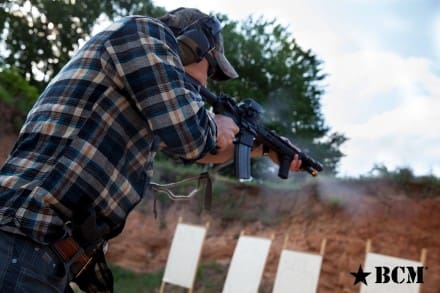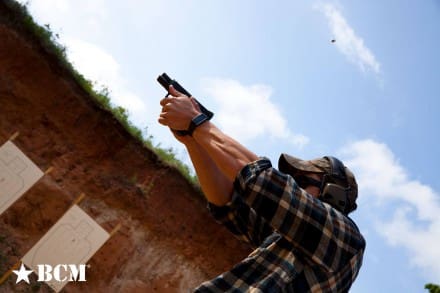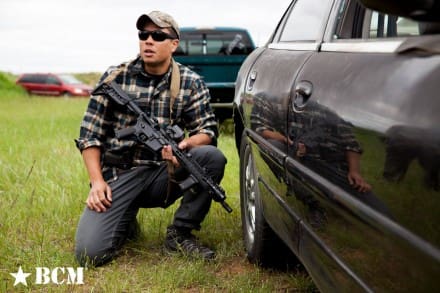Aaron Barruga
May 2017
By his 20th iteration, an Afghan guerrilla with minimal marksmanship training was shooting the 2x2x2 exercise just as efficiently as Instagram tactical celebrities. Only an hour earlier had we discussed some key points of marksmanship, then I gave him a crate of ammo and coached him through each repetition of the exercise. Two weeks later, that same guerrilla fled his checkpoint during the initial phase of Taliban attack. So what happened?
Obviously there is no link between how quickly we can shoot an exercise and our performance in battle. Regardless, as tactical shooters we can be notoriously bad at searching for significance where there is none, or misreading the real importance of a shooting drill. We see this happen quite a bit with speed. Everyone wants to be faster, which is fine, but faster does not always correlate with better.
For novice shooters, static speed shooting exercises help develop confidence and proficiency. For experienced shooters, speed exercises become a measurement of how well we can learn a sequence and perfect our movements. Neither of these are bad, however, the seductiveness of a rapid rate of fire can cause shooters to focus on the wrong aspects of their performance. Moreover, while pursuing speed it can become easy for us to neglect the development of discipline that forces us to proactively see our sights.
We retroactively see our sights by hijacking our natural point of aim. I see this happen a lot at the seven yard line. Whether with a pistol or carbine, shooters just point and squeeze their trigger as soon as they “feel” their sights are in the right spot. We become so focused on beating a time standard that we neglect the unintended development of bad habits. Although it is important to understand where your body naturally presents your sights, it can build a false positive regarding performance feedback.
I experienced these effects as a junior team guy. As a novice, I obsessed over how quickly I could shoot a string of five rounds at two targets, perform a reload, and then shoot the exercise again. Although I was developing confidence, it was at the expense of incredibly sloppy speed. During a force on force scenario I rushed my shots in a shoot house and either missed or landed wounding shots that would fail to neutralize a threat. The cadre pulled me aside and told me to discipline my fire and see my sights. Roger that, see my sights, no issue. The next run through I continued to rush my shots and not enforce any discipline because I had performed so many garbage reps shooting for speed.
Because I had developed quick, but sloppy hand speed, I assumed that the cadence at which I shot rounds against cardboard represented how quickly I needed to shoot a gun against a real threat. The next day, the cadre demonstrated their run through the force on force scenario. None of their shots were rapid fire and their cadence was entirely sporadic. They only shot when they saw center on the OPFOR, and instead made up for speed with efficiency moving in between rooms.
From a tactical marksmanship standpoint, everything comes down to whether or not you can present your sights, and then exercise discipline when squeezing the trigger. That’s it. Marksmanship exercises ensure we understand how to use a weapon, but it is actually really hard—as demonstrated by the Afghan guerrilla and myself—to design shooting exercises that create a reliable baseline for real world performance. Yes, trim the fat and sharpen your mechanics, but do not assume a sub one second draw, or a sub two second 2x2x2 signifies the most important aspects of training.
Unfortunately, it can be incredibly difficult to convince a shooter of the aforementioned. The martial nature of combat marksmanship encourages us to seek out sequences, and then shoot those sequences as fast as we can. Learning a sequence, then following all of the steps to perform that sequence makes us feel good about ourselves. This is also why so many shooters never break their plateau. Because they have a pre-shooting sequence, and a post-shooting sequence, shooters can poorly perform a shooting exercise by shooting as fast as possible, but because they did their pre and post sequences, they mentally check the box and reward themselves for following a list of steps. Pre and post shooting sequences are not bad. However, assuming they signify proficiency is akin to assuming that the pre-lift act of adding weights to an olympic bar, then the post act of removing them signifies our ability to power clean.
We must encourage shooters to develop speed through exercises such as 2x2x2, but all speed must be followed up with discipline. Aggressively driving our sights to the center of an easy hit target helps develop novices, but plateaus the seasoned marksman. Worse, it is easy for experienced shooters to slip into auto-pilot in which they are not truly seeing their sights, and are instead seduced by the rapid rate of fire in an exercise.
Although we need to develop the confidence to shoot quickly while under stress, we must always reinforce discipline. Shooting a string of five rounds at a cardboard target only requires us to drive our sights back to a single plain, and thus we can unintentionally hijack our natural point of aim. But remember, real flesh moves. Shooting five rounds at a living breathing target causes the target to move after each round, and results in five separate plains where we acquire sight picture. If we’ve spent our range time chasing speed and building sloppy habits, we can set ourselves up for failure when we encounter a real target that requires a slower rate of fire in exchange for more precise shots.
Aaron Barruga is Special Forces veteran with deployments to Iraq, Afghanistan, and the Pacific Theater of Operations. He has trained foreign commandos, police officers, and militia fighters. He is the founder at Guerrilla Approach LLC, where he consults law enforcement officers on counter-terrorism and vehicle tactics.
www.guerrillaapproach.com
www.facebook.com/guerrillaapproach
www.instagram.com/guerrilla_approach
Gunfighter Moment is a weekly feature brought to you by Bravo Company USA. Bravo Company is home of the Gunfighters, and each week they bring us a different trainer to offer some words of wisdom.
Tags: Aaron Barruga, BCM, Bravo Company USA, Guerilla Approach





Good article Aaron; efficiency comes with being able to execute the basics flawlessly and think your way thru advanced problems on the move.
That was a fantastic article, a true keeper. I’ve learned just enough and participated in drills and shoot house drills just enough to know this is just dead on correct.
After a few years of active participation in advanced training, I have lost track of how many times I’ve seen “competitive” shooters absolutely fall apart under the stress of anything even approximating a real-world/high stress scenario in a shoot house with gunfire taking place, etc. Clearing rooms in teams, etc.
And anytime I begin to think I’ve “got this” …. boom … along comes a high stress drill that absolutely kicks my ass.
Now, I can’t even imagine what it must be like to have all this going on and actual combat spinning all around.
This article echos everything our instructors keep trying to pound into our thick heads…I enjoy the challenge of my “weekend warrior” training, and my admiration for the men who have been there and done that, and are there and are doing that, continues to soar.
Thanks for a GREAT article.
Thank you Aaron for taking the time to put together a wonderful read! I’m off to the range this Memorial weekend and will print this out and take it along.
one of the best guest posts in a long time.
Exactly, threats are not cardboard.
Awesome GF moment, thanks Aaron as always.
excellent read, more GF moments like this please.
Very good article. Well done and thank you for sharing.
Excellent, excellent article.
The key takeaway is the difference between proactively seeing the sights and retroactively – when pushing for speed, it’s far too easy to say to yourself “OK, yeah, my gun was generally up and aligned therefore I must have seen my sights well before squeezing the trigger” – instead of what should be done, actively seeing the sights on the target before squeezing the trigger. The difference between actually doing, and rationalizing afterwards that you must have done (despite the lack of center-mass holes providing actual evidence).
We hear over and over the mantra “You can’t miss fast enough to win” – but too few are able to have the self-discipline to actually slow down and apply the fundamentals every time, even when that is what’s needed to make the hits.
Really good point.
Generally speaking, the “speed” at which you win a close in gunfight (0-10 meters) is really the speed which is derived at a sub-conscious level which is hard to articulate. When you’re shooting at these speeds, you’re not saying anything really memorable enough to a) remember or b) to conscientiously discern at the time you’re performing that task. So, when I hear a reference to making a conscientious thought about sights and fundamentals at very close ranges (0-10 meters) I cringe…just a little…which is why I try to train (and train those I train) to execute the fundamentals “without thinking about it” (i.e., sub-conscious).
Great article.
What do you think would be the best way to improve training to better mimic reality? More reliance on 3d moving targets and FoF training?
Wow…a whole lot here to unwrap…all I can say is you can’t train to be courageous. No matter how well you train, in combat, the human psyche suffers from unpredictable occurrences which makes one have to fight the urge to want to flee (ie. fight or flight). The example of the Afghan Commando (i’m assuming here given Barruga’s being a Group guy) has absolutely no real explanation you can draw from a shooter being good and fast at a certain flat range drill. Bottom line: YOU CAN’T TRAIN COURAGE. Further, i don’t even know what to make of this statement here: “We retroactively see our sights by hijacking our natural point of aim.” WOW…I don’t even know what that means. Another bottom line: I have a lot of experience (as I’ve been doing what I do since 1983) and the one thing I will say is that if someone can’t understand a statement that sounds great on the surface (such as the one I quoted) but can’t take away the “take away” from it, then it’s just a bunch of words…sorry, but those who know me know I have a tendency to be harsh when I believe something is being sold that doesn’t need to be bought…
I would agree that some people are born more courageous than others, however with the proper training in the proper fundamentals and by developing a fighting mindset this can be overcome. Below are some links that go into a much more indepth and well worded explanation.
http://www.violenceofmind.com/blog/mindset-orientation-to-violence
http://www.onelifedefense.com/blog/fighting-mindset-orientation-and-ooda
http://www.onelifedefense.com/blog/i-don-t-need-more-fundamentals-go-home-tacticool-sauce-yo
Tough, realistic, disciplined training that challenges the individual physically, technically, and mentally builds confidence and competence that lend themselves to succesful performance in adverse conditions.
Courage isn’t applicable. Technical competence and confidence is performing the task (shoot people trying to kill you) is applicable. You train in it, harder and harder until it happens and you’re ready to perform the task.
The (presumably) local militiaman wasn’t disciplined in his technical training, and wasn’t confident in his ability to perform the task. The author with over a decade in repeatedly training and refining his technical skills is.
“Courage isn’t applicable. Technical competence and confidence is performing the task (shoot people trying to kill you) is applicable. You train in it, harder and harder until it happens and you’re ready to perform the task.”
Not sure I agree with this statement…I need to think about this one before I answer fully. That being said I’ll say this…the example Barruga cited in his article of the Afghan running from his position, after having mastered a specific flat range drill, implies, TO ME, Barruga is drawing a corollary with range competence not necessarily lining up with courage on the battlefield. The given example leaves too many holes to fill for me to fully understand 1) what was the circumstance that drove him to leave his position?, And 2) how does him running away ratify that competence and mastery of a skill (albeit a specific flat range drill) align with “courage” in a gunfight – or not? This is the gap I see in the thesis…but hey…remember, I’m only a sample of one so I could be way off here…
I’m right there with you man. Guess that makes a sample of two.
I just spent a week at Gunsite for their 250 pistol. After three days of paper target shooting at different distances and speed drills on steel, they ran us through the indoor simulator. Many of the students (including myself) under the “stress” of going through the Funhouse completely forgot everything the instructors taught us about marksmanship and proceeded to point shoot every target. Afterward, they reminded us about front sight focus and squeezing the trigger. The second runs were better for most of us. Great article.
So three days of training and everyone failed a stress shoot on the first run? Great training!
This is gospel.
Just echoing the previous sentiments. Some excellent info and philosophy to add to my range time.